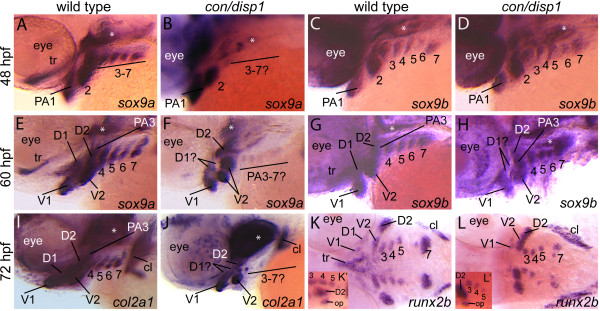Figure 3.
Chondrogenic differentiation in con/disp1 CNCC. Lateral views of 48 hpf (A-D), 60 hpf (E-H), 72 hpf (I,J) or ventral views of 72 hpf (K,L) wild type (A,C,E,G,I,K) or con/disp1 (B,D,F,H,J,L) embryos labeled with RNA probe for sox9a (A,B,E,F), sox9b (C,D,G,H), col2a1 (I,J) or runx2b (K,L). (A,C) sox9a marks CNCC in PA1-7 at 48 hpf in wild type embryos (A), however expression is lost in the posterior arch-residing CNCC in con/disp1 mutants (E). (C,D) sox9b continues to be expressed in 48 hpf PA1-7 condensations in wild type (B) and con/disp1 mutants alike (D). (E-H) At 60 hpf, sox9a and sox9b becomes downregulated in the dorsal subset of con/disp1 CNCC in the anterior arches (D1 and D2). sox9a remains absent in posterior arches in con/disp1 mutants, while sox9b remains robustly expressed in posterior arches. (I,J) At 72 hpf, col2a1 is reduced in con/disp1 D1 and D2 condensations and absent in PA3-7. (K,L) At 72 hpf, runx2b is absent in con/disp1 D1 and dorsal trabeculae precursors, but is present in PA condensation at wild type levels. (K',L') insets are of lateral views of same embryo shown in (K) and (L) respectively. Lateral views show presence of runx2b expression in opercle condensation in con/disp1 and wild type embryos alike. Asterisks indicate expression in mesoderm-derived polar cartilages. Images are at same magnification.

